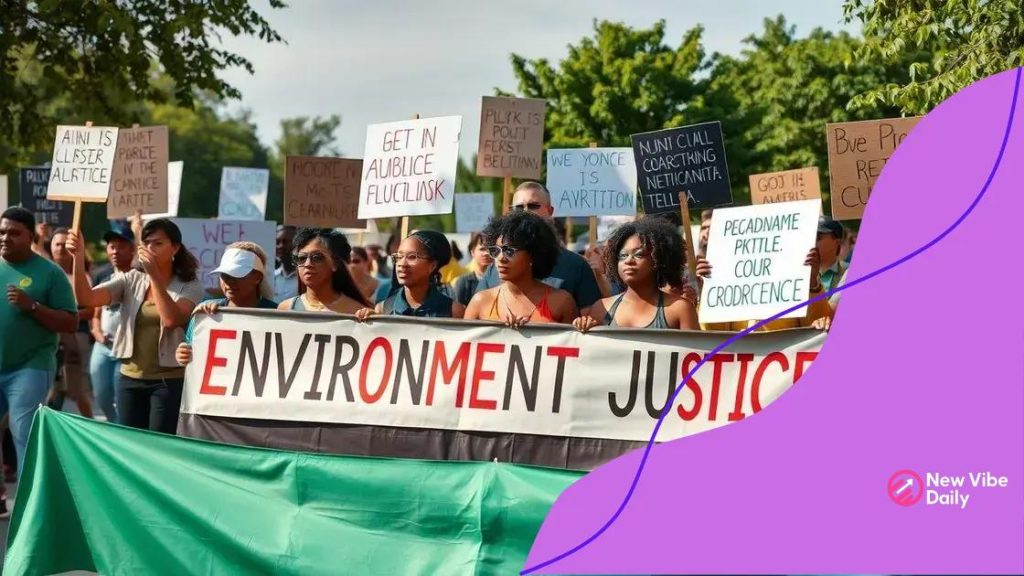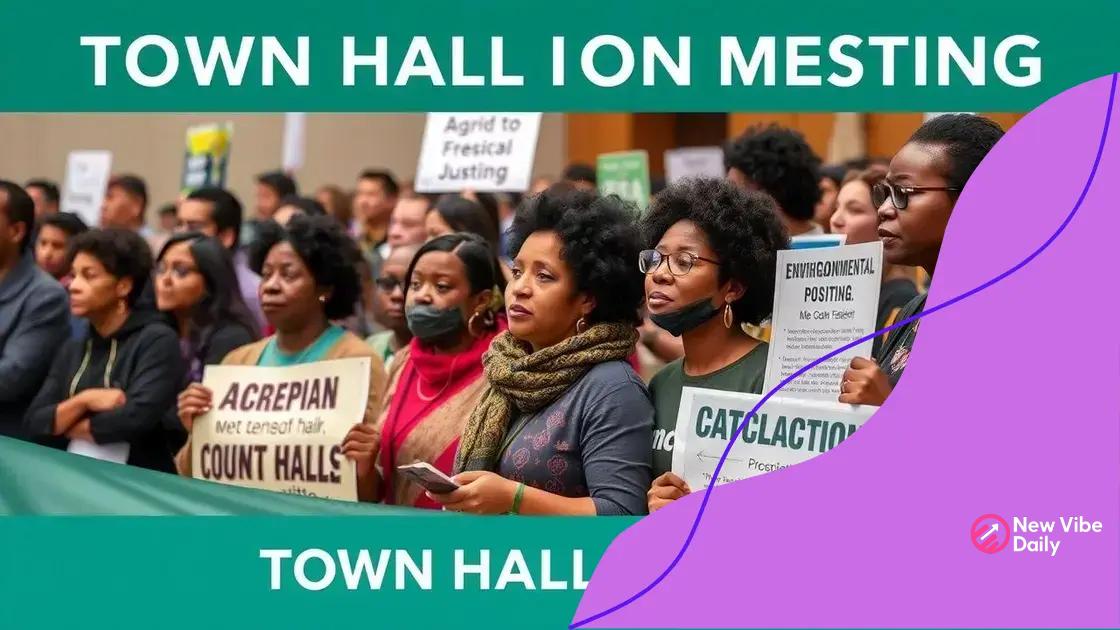Debates surrounding environmental justice: what you need to know

Debates surrounding environmental justice focus on ensuring fair treatment and involvement of all communities in environmental policies, addressing issues like pollution, access to resources, and community advocacy that influence significant policy changes.
Debates surrounding environmental justice are becoming increasingly important as communities fight for equitable treatment in environmental policies. Have you ever considered how these discussions may affect your own neighborhood or the air you breathe?
Understanding environmental justice concepts
Understanding environmental justice concepts is crucial for grasping the complexities of how environmental policies affect communities. At its core, environmental justice advocates for the fair treatment and meaningful involvement of all people, regardless of race, color, national origin, or income, in environmental laws and policies.
This concept addresses the disproportionate impact of environmental hazards on marginalized communities. Historically, these areas have been locations for toxic waste sites, landfills, and industrial pollution, which raises serious health and environmental concerns.
Key Principles of Environmental Justice
There are several principles that guide the movement for environmental justice:
- Equitable distribution of environmental benefits and burdens.
- Community involvement in environmental decision-making.
- Recognition of the rights of indigenous communities and marginalized groups.
The goal is to create a more equitable balance in how environmental risks and benefits are distributed. Understanding these principles helps us address the issues faced by disadvantaged communities.
Furthermore, many organizations work towards promoting these principles by advocating for stronger regulations and policies that protect vulnerable populations. For instance, they lobby for stricter pollution controls and safer working conditions in commercially exploited areas.
Real-life Implications
Environmental justice is not just a theoretical concept; it has real implications for affected communities. When policies are put in place that disregard these principles, it can lead to devastating outcomes, such as increased health problems and reduced quality of life.
By raising awareness of these issues, communities can empower themselves to demand their rights and justice. Community-led initiatives often focus on educating residents about their rights and engaging them in local governance.
Ultimately, understanding environmental justice concepts helps foster a more inclusive dialogue on how we can collectively work towards a fairer future for everyone. Policies rooted in these principles can lead to healthier environments and resilient communities.
Key issues in current environmental justice debates
Key issues in current environmental justice debates highlight the ongoing struggles for equity in environmental policies. These debates play a crucial role in shaping communities and the environments they live in.
One major issue is the impact of pollution on marginalized communities. Many low-income neighborhoods and communities of color often face higher levels of exposure to harmful pollutants. This situation raises concerns about public health and the right to a clean environment.
Displacement and Land Rights
Another pressing issue is the displacement of communities due to environmental policies. For instance, many residents are forced to leave their homes for developments like highways or industry expansion. They often have little say in these decisions.
- Displacement leads to loss of community.
- Land rights violations can exacerbate poverty.
- Access to affordable housing is compromised.
These factors contribute to the ongoing cycle of injustice faced by vulnerable populations. The fight for land rights combines environmental advocacy with social justice efforts.
Furthermore, climate change is a topic that cannot be ignored in these debates. Vulnerable communities frequently bear the brunt of climate-related disasters, such as floods and heatwaves. These events further stigmatize affected neighborhoods and reduce their capacity to recover.
Access to Resources
Access to clean water and healthy food is a critical issue as well. Many disadvantaged communities struggle with food deserts and lack of clean drinking water, directly affecting their quality of life. This reinforces the importance of including environmental justice in discussions about food security and public health.
Engaging communities in decision-making processes is essential to address these issues. When local voices are heard, more effective solutions can be developed that benefit all residents. Holistic approaches that incorporate local knowledge can lead to better environmental outcomes.
Despite the challenges, ongoing activism and community organizing continue to bring attention to these key issues. By uniting different groups under the banner of environmental justice, advocates work towards creating policies that foster fairness, equity, and healthier environments for everyone.
The role of communities in advocating for justice

The role of communities in advocating for justice is fundamental in the fight for environmental fairness. Communities often serve as the first line of defense against injustices they face. When local residents come together, they form a powerful voice that can lead to significant change.
Grassroots movements are essential to this advocacy. They mobilize individuals and create awareness about local environmental issues that affect their health and quality of life. These movements empower residents to engage in discussions and advocate for better policies.
Building Stronger Networks
Communication within and between communities is vital. By sharing information, resources, and strategies, groups can strengthen their advocacy efforts. Common strategies include:
- Organizing community meetings to discuss local issues.
- Partnering with non-profit organizations to gain more support.
- Creating educational campaigns to inform residents about their rights.
Through these efforts, communities can effectively raise awareness and create a united front against environmental injustices.
Furthermore, community participation in decision-making processes is crucial. Many environmental policies directly impact local areas, yet the residents are often not included in the conversation. Advocacy groups work to ensure that the voices of those most affected are heard in discussions that shape their environments.
Local and National Impact
When communities stand up for their rights, they can influence larger policy changes. Local actions can lead to national reforms. Many successful environmental justice campaigns began with small community initiatives that garnered attention and support beyond their regions.
This chain reaction often inspires other communities to organize and advocate for their rights. As more residents engage in the fight for justice, the movement gains momentum, leading to broader societal changes. By standing together, communities not only protect their own interests but also contribute to a more just and equitable society.
Ultimately, the role of communities in advocating for environmental justice is a testament to the power of collective action. Through solidarity and resilience, they are capable of challenging injustices and creating positive change.
Impact of environmental justice on policy-making
Impact of environmental justice on policy-making is a critical area of discussion as it shapes the regulations and laws that govern our environment. Environmental justice movements have influenced how policies are formulated, ensuring that they account for the needs of marginalized communities.
One significant impact is the inclusion of community voices in the policy process. Historically, many policies were developed without input from those directly affected by environmental issues. Today, there is a growing recognition that community involvement leads to more effective and fair policies.
Policy Changes Driven by Advocacy
Advocacy groups highlight key issues that demand attention. They bring awareness to problems like high pollution levels and inadequate access to resources.
- Citizens have successfully lobbied for cleaner air and water regulations.
- Communities have pushed for improved environmental assessments before new developments.
- Grassroots campaigns have resulted in stronger enforcement of environmental laws.
These efforts not only elevate the voices of affected communities but also demonstrate the power of organized advocacy in driving change.
Moreover, national and local policies are increasingly considering equity in their frameworks. For example, environmental impact assessments now often require that the potential effects on disadvantaged groups are analyzed. This change ensures that decision-makers understand how policies will affect all communities, not just the privileged.
Long-term Effects on Legislation
The long-term effects of integrating environmental justice into policy-making can lead to more sustainable practices. As policies evolve, they promote green initiatives that prioritize the health of both people and the planet.
For instance, cities adopting sustainable urban planning methods often consider the needs of underserved communities. This approach helps reduce environmental burdens while also enhancing the quality of life for residents.
By recognizing the interconnectedness of social and environmental factors, policymakers can create legislation that promotes justice and fairness. The ongoing influence of environmental justice on policy-making will likely continue to shape regulations in the years to come.
Case studies highlighting environmental justice battles
Case studies highlighting environmental justice battles provide valuable insights into how communities have fought for their rights and achieved significant victories. These stories not only inspire but also show the practical implications of advocacy and activism.
One prominent case is the fight against toxic waste in Love Canal, New York. In the late 1970s, residents discovered that their neighborhood was built on a toxic waste dump. They organized protests, demanding action from government officials. Their activism led to the establishment of the Superfund program, aimed at cleaning up hazardous waste sites across the country.
Community Action in Flint, Michigan
Another critical example is the Flint water crisis. In 2014, the city’s drinking water became contaminated with lead when a cost-cutting measure changed its water source. Residents, primarily from low-income areas, raised alarms about the water’s safety.
- Grassroots organizations mobilized community meetings to discuss the issue.
- Civil rights groups joined the fight, amplifying the residents’ voices.
- National attention was drawn to Flint, leading to investigations and policy reforms.
This case highlights the power of community action and advocacy in addressing urgent environmental health issues.
Another significant battle occurred with the Dakota Access Pipeline. Indigenous communities and environmental activists protested against the pipeline’s construction, fearing it would endanger their water supply and sacred lands. The protests gained national and international attention, leading to discussions about indigenous rights and environmental protection.
Saving the Everglades
The restoration of the Florida Everglades is another case worth noting. Advocacy groups have fought to reclaim and protect this essential ecosystem from urban development and pollution.
Efforts included raising public awareness and lobbying for policy changes. Key victories include:
- Securing funding for restoration projects.
- Implementing stricter regulations on pollutant discharge into the wetlands.
- Involving local communities in conservation efforts.
These case studies demonstrate the importance of grassroots movements in attaining environmental justice. By coming together, communities can challenge injustices and work towards sustainable solutions that benefit everyone.
FAQ – Frequently Asked Questions about Environmental Justice
What is environmental justice?
Environmental justice is the movement to ensure that all communities have equal access to a healthy environment, including clean air, water, and land.
Why are community voices important in environmental justice?
Community voices are crucial as they provide firsthand experiences and insights that can shape policies to better address local environmental issues.
How can grassroots movements influence environmental policy?
Grassroots movements mobilize community members to advocate for their rights, often leading to significant policy changes at local, state, and national levels.
What are some successful examples of environmental justice battles?
Successful examples include the Love Canal crisis and the Flint water crisis, where community advocacy led to substantial policy changes and greater awareness of environmental health risks.






